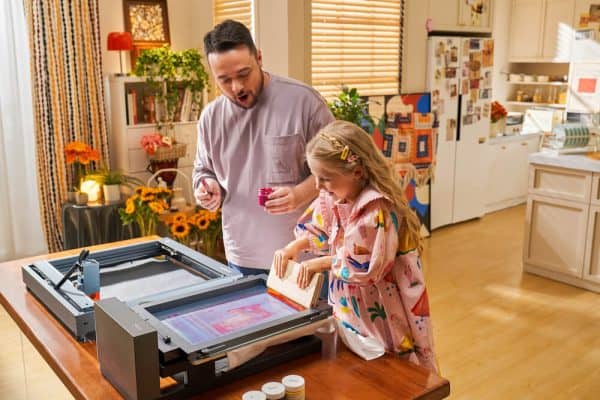In This Article
This post may contain affiliate links. If you make a purchase through links on our site, we may earn a commission. And if you do that, you are AWESOME!!! Thanks :)
If you’ve been following Repurposing Junkie for a while now you know we dabble in a little bit of everything. From Cricut crafting, to punch needle, to printable coloring pages. Now, with our xTool laser engraver and their new xTool screen printer we’ll be whipping up some brand-new screen-printed creations in 2024 and beyond!
In the past, I’ve dabbled in some screen printing for fun and more as a hobby. But I personally always wanted to do short-run t-shirts and other screen-printed products as an actual business. I tried making up my own screen printing screens from scratch with emulsion, exposure, drying…but the process was way more involved and time-consuming than I wanted for the small business idea I wanted to pursue.
So when I first heard about the xTool screen printer product I was intrigued. I’ll admit I was a bit skeptical at first after how involved the process had been to make my own screen printing screens from scratch, but then it hit me — if the pre-coated screens could be etched out with the laser machine I already had what a time-saver this would be! I had to do some more research and see if this was going to be as good of a tool as I thought it was going to be.

Advantages of the xTool Screen Printer
Like I mentioned in the intro, I used to do some screen printing as a hobby. But I never got the hang of making my own screens to a level that would produce the crispness of the lines when I inked up my screens. So I ended up sending my files to a professional screen printing company and spending $50 – $100 to have them make me the screens and ship them to me. I no longer have to do that with the xTool screen printer — I can make super sharp, letter-perfect screens in literally a fraction of the time. It’s awesome!
For example, I made some fun shirts with a friend’s face and a lot of thin-font text. I just couldn’t get the emulsion the way I wanted it to give the quality I wanted in the end. So I hired out the screen manufacturing, bought a new flat shirt press and freestanding flash dryer and the results were great.

Nowadays, I can whip up a design on Canva, in Adobe Illustrator, or wherever then send it over to xTool Creative Space. Then it’s just a matter of etching the design on the screen and popping the framed screen onto the xTool screen printer and inking up my t-shirt, bag, or whatever I’m creating. It takes just a couple hours total working time and I’ve cranked out a dozen t-shirts instead of literally days before for the whole process I was doing.
How to Use the xTool Screen Printer
The process for using the xTool Screen Printer is quite simple! If you’ve ever done screen printing before, this will be super easy. And if you’re totally new to printing on fabrics with ink and a squeegee, the process will be no problem once you run through the steps a few times. Make sure to watch the video below after reading the steps so you can see a full hands-on demonstration of 3-color printing with the xTool screen printer.
- Create your design and separate your layers if doing multi-color.
- We recommend using either xTool Creative Space (free with your xTool laser machine) or Lightburn software.
- Make sure to turn off layers that will not be used for this screen (if doing multi-color you’ll need to etch a new screen for each later).
- Make sure the six (6) toggle levers on your xTool metal frame are in the open, unlocked position.
- Lay your emulsion-coated screen on the xTool metal frame, with the fabric/tape tabs on top of the frame. Do not push down yet.
- Insert the four (4) tightening rods into the slots on the metal frame. As you push the rods down into the slots, this will press the fabric/tape tabs down into those slots for the initial tightening of your emulsion-coated screen. As you get each rod down into the slot, rotate it so the flat part of the rod sits on top of the frame to help keep it secure.
- After the four (4) tightening rods are in place, flip the six (6) toggle levers to the locked position so they tighten the screen fully. If you see any loose areas on the screen, you may want to unlock the toggle levers and tightening rods to get things nice & tight. Once you get the hang of this process it’ll become second nature for you.
- Use the aligning bar on your xTool D1 to keep your screen in a specific position. Place the metal frame that is holding your screen onto the two pins on the aligning bar. Push back onto the posts to ensure proper positioning (watch Ashlee’s video at the 11:30 point to see this process).
- Start the laser etching process for your design. If you’re using xTool Creative Space, a good starting point for your settings is: Power = 60, Speed = 80.
- Once the laser etching process is complete, you’re ready to start using ink to place your designs on fabric & objects using your xTool Screen Printer! Keep the screen in your metal frame, you can reuse your screens over & over if you keep them clean after printing.
(Keep in mind though, that you’ll need to buy more metal frames if you’re going to keep reusing your existing screens and keep making new screens. If you’re running a business, it’s always a good idea to keep those old screens stretched tight so you can just grab them off the shelf and start printing anytime.) - Attach your screen in the metal frame to the xTool Screen Printer.
- Place your material/object onto the sticky platform below where you attached the metal frame with your etched screen. Make sure it’s flat, tight to the platform, and wrinkle-free.
- Lower the metal frame down onto your material/object, lock it in place with the turn knob, then load some ink onto the emulsion screen.
- Pull the ink across the etched screen in one continuous motion. Scrape any excess ink back into your ink jar if you’d like to save it to reuse later.
- Wait a minute or two for the ink to settle, then release the turn knob and lift the metal frame off your material/object.
- Use a heat source like a hair dryer or a screen printing flash dryer to set the ink on the material/object.
- If you’re printing multiple colors, load up the next screen and repeat steps 10-14. If you’re only doing one color, you’re all done!
But don’t just take my word for it. Ashlee Falco does an amazing job showing you the ins & outs of using the xTool screen printer on her YouTube channel. The video below is her 3rd in the process of getting to know the machine, and her xTool screen printer tutorial video even shows you step-by-step how to do 3-color printing on a t-shirt. I have to admit, after watching Ashlee’s trial & error and then seeing how she developed a slick process for doing multi-color screen prints with a laser engraver and the xTool screen printer, I was 100% sold.
What can you make with the xTool Screen Printer?
Just like any other screen printing project, you can print on so many different things with the screens you etch for the xTool Screen Printer. You just get to use them in a fraction of the time since you can go from etching to printing in literally minutes!
Think of all the things you might want to print your ink on and it’s probably on the list. T-shirts and tote bags are the obvious first choices. Then think of flattening out can & bottle koozies, pillow cases, paper & posters, towels, notebooks, wood, headbands…even aprons or umbrellas! Your imagination is the only limit (and the size of the xTool Screen Printer platform of course).
Can You Reuse the Emulsion-Coated Screens that xTool Sells?
You bet! That’s the great thing about the design of these emulsion-coated screens that xTool offers. You can keep them intact and reuse them as long as you’d like. Just keep them clean (wash the unused ink off) and store them away. Or, if you have space left on the screen where you didn’t etch, you can squeeze a couple more designs on the same screen and just ink up that part on your design. That’s more of a thing to do for testing & small projects though. It’s not super easy to just use little sections of your etched screens in my opinion.
Where to Buy the xTool Screen Printer
Right now, the xTool screen printer is only available for advanced purchase on Kickstarter. Once those initial Kickstarter orders are fulfilled I’m pretty sure they’ll be putting this amazing tool into production though, and I’ll update this article with links to the actual product pages so you can do a bit more research yourself.
If you find this valuable and end up purchasing an xTool screen printer (or are still in the excited pre-purchase phase like I was and have some thoughts), let me know what you think of it in the comments below!

Thanks Cory. Great informative article a such a new product. I’m more of a hobbiest so the basic version of the kit is closer to my budget.
Because it has one frame and 3 screens, I’m going to need to figure how to un-spring and un-frame the screens move between designs and layers. Is that possible? Plus I’m unclear on how I could re-emulsify a used screen.
Might you be able to provide more information?
Hey Scot. Thanks for the feedback. The xTool screens are geared toward re-emulsifying at this point in the product’s development. They’re more for single use & storage to re-use for the same design later. If you’re doing multi-color, I’d make sure you create a common registration mark on your screens for each layer that you avoid getting ink into (I’ve used gaffer tape to cover up the registration marks on other screens). That way you can get that registration mark lined up perfectly with the previous inking on the fabric/material as you load a new screen prior to inking. Hope that helps!
..sorry meant to subscribe.
Do you know if you know if you can use other silk screen and can you remove and recover the silk screens supplied
Hi Donna! Thanks for the question. Using screens other than xTools is not recommended with a laser engraver since any non-metal mesh used for a silkscreen would likely be damaged by the laser itself when it burns away the areas you want to print.
We haven’t tried removing the xTool emulsion from their proprietary frames and re-applying a traditional emulsion (or alternatives like this one with acrylic paint). If we see someone trying that out though we’ll definitely share it here!
Just curious, can you use score to do the screen or only engrave?